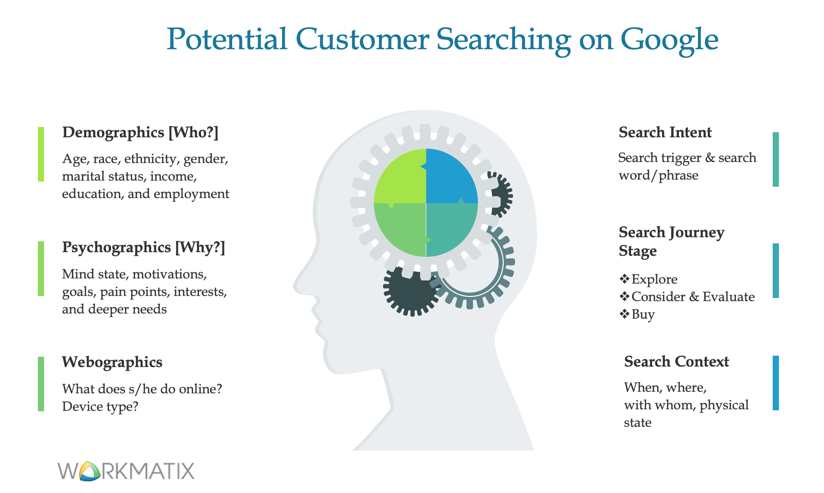Want to know what your users are really looking for? It’s almost like reading their minds, but with data! Tap into the different categories of keyword intent — commercial, navigational, transactional, informational — so you can create tailored content with user intent at its core.
Detecting Search Intent

Data will also allow you to detect intent. For example, imagine that you can see the search terms of someone named Maria, who has signed up for a marathon and is interested in purchasing new running shoes.
If she types in “running shoes,”‘ that’s pretty vague. Based on that search term, it’s highly likely that she is just browsing to find more information and she is not ready to buy yet.
Then you see that Maria typed in “long distance running shoes for women”. Now she’s narrowed her searches down to specific but it is still pretty vague, but more specific than before.
Maria then searches for “Asics vs. New Balance running shoes.” Now it’s clear that she is researching and tries to compare the options. Her decision about which one to go with is very much in play. (It’s a great time to be showing her ads about “Compare Asics running shoes” if your brand is Asics for example.)
By the time Maria types in “Asics women’s GT-10004 running shoes teal”, we have an extremely strong idea of her intentions: this person knows the specific solutions she’s after and now the only likely question is who meets her current needs on price, availability, and so on.
That’s a simple example, and data scientists get much more sophisticated at discerning intent from the literally billions of data points they crunch.
Customer Search Journey Keyword Types:
“Cold traffic” – looking for ideas or information.
“Informational” keywords align with the first stage of the buyer’s journey – where the user is aware that they have a problem and are seeking a solution.
These tend to be “I want to know” keywords that lead them to informative content.
Examples:
“do I need a lawyer”
“family lawyer Minnesota”
“family holidays”
“family winter holidays”
“family trip ideas”
“what does a life coach do?”
“benefits of life coaching”
“home inspection tips for buyers”
“window leaks when it rains”
These keywords tend to include:
- How;
- what;
- who;
- where;
- guide;
- tutorial;
- resource;
- ideas;
- tips;
- examples.
“Warm traffic” – comparing or researching
“Consideration” keywords help users find a specific brand, product, or service. They are already aware of the options and now are trying to make a decision.
Google will likely show users content from websites that they have looked at previously.
Examples:
“Nancy Johnson law firm reviews”
“Nancy Johnson law firm”
“best family lawyer in Minneapolis”
“best ski resorts Colorado”
“ski resorts USA”
“top ski resorts usa”
“luxury ski resorts Colorado”
“life coach vs therapist”
“house mold inspection companies”
“windows replacement assessment”
These keywords types tend to include:
- Location;
- Brand names (if applicable);
- Name of a product;
- Name of a service.
“Hot traffic” – ready to act/purchase
These “conversion” keywords match the final stage of the buyer’s journey – when a user has done their research, explored their options, and is ready to buy, sign up, or hire.
Examples:
“Nancy Johnson free consultation”
“call Nancy Johnson law firm”
“directions to Nancy Johnson law firm”
“hire a life coach near me”
“life coach Edina”
“mold inspection Minneapolis”
These keywords tend to include:
“apply”
“buy”
“discount”
“where to buy”
“schedule appointment”
[city] type of store
“pricing”
Use search intent analysis to create search-friendly content for your website. Treat the themes of intent you identify like a content design checklist.
Does your content speak to these needs? If not, should this topic be addressed on an existing page, or is it deserving of its own? Leverage search volume to prioritize how high on the page that content should live, or to determine information hierarchy. Make sure the keywords your company uses in web copy, navigation, and category labels mirrors the language people use to describe things themselves.





